VIEWS AND OPINIONS
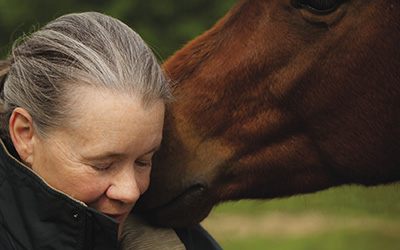
Courtesy of Maria Korab-Laskowska
Can Praxis: A Model of Equine Assisted Learning (EAL) for PTSD
by C. Randy Duncan, Steve Critchley, and Jim Marland
For more information on accessing this file, please visit our help page.
Introduction
“While the Canadian Armed Forces use teambuilding, communications training, and leadership to prepare soldiers for war, Can Praxis uses them to help soldiers and their families to recover from it.”
– Steve Critchley & Jim Marland
The rehabilitation challenges faced by veterans suffering with post-traumatic stress disorder (PTSD), including operational stress injury (OSI), are monumental and exacerbated by unfinished business.1 The lack of deprogramming and support for veterans to transition from a combat role to a civilian role typically results in individuals who constantly maintain an edge, and who can, in a given moment overreact, becoming too angry, too aggressive, and/or too anxious.2 Consequently, this road has all too often led to a diagnosis of PTSD, which we believe is tantamount to calling a veteran ‘weak,’ and is perhaps the worst label one can attach to a soldier. So, veterans battling the dissonance between being labelled ‘weak,’ and wanting to be strong, are not well prepared to talk about their problems, to be emotionally connected partners in personal relationships, and/or to integrate back into civilian life. If veterans with PTSD are unable to find a way to communicate effectively within their civilian relationships, their comfort zone will continue to shrink until their relationships are beyond repair, or, worse yet, the only thing left for them is to be the next one to ‘lay down in front of a GO Train in Toronto.’
There has been rapidly growing interest in Canada with respect to the association of ‘horse therapy,’ or equine assisted learning (EAL), for treating individuals suffering from the effects of OSI. Subsequently, Veterans Affairs Canada (VAC) has come under increasing pressure to fund appropriate and complementary treatment therapies for veterans in more conventional treatment tracks for OSI. The decision by VAC to fund a portion of the pilot testing of the Can Praxis EAL program in 2013 comes on the heels of a joint initiative of VAC and the Department of National Defence (DND) to develop a mental health strategy to enhance the supports and services provided to the growing number of veterans with OSI.3 In Canada, over the past decade, the number of VAC clients identified as having OSI has increased from 3500 to more than 11,000. Consequently, combat PTSD is the most commonly diagnosed mental health condition affecting Canadian veterans, derived from the reality of almost 60 percent of VAC clients having received a favourable decision for disability benefits having OSI.4
The EAL industry is uniquely positioned to provide an appropriate form of experiential learning therapy for veterans and their spouses/partners suffering from the effects of OSI. In general, the role of animal-human interactions has been postulated to promote wellness and to prevent illness.5 Through interactions with horses, people find profound opportunities to modify their behaviour by learning to trust themselves and to become empowered in ways that cannot be accomplished through just conversation.6 The idea of conventional PTSD therapy for many combat veterans is unnerving, because many therapists do not fully understand the military persona and/or are insensitive to the psychological aftershocks of intense trauma.7 Understanding the potential use of horses for behavioural modification, Can Praxis offers an innovative approach that combines EAL activities with a self-mediation process to leverage participant self-awareness of key communication and conflict resolution concepts.
To the extent EAL is uniquely positioned to help veterans recover from the effects of OSI, Can Praxis is uniquely positioned within the EAL industry itself. The founders of Can Praxis have developed an innovative PTSD-tailored EAL curriculum to meet the needs of veterans suffering with OSI. A key strength of the Can Praxis program is including the veterans’ spouses/partners in the experiential learning process to ensure that the more subtle but crucial communication skills (first attempts at making a conciliatory gesture) do not go unnoticed in the critical early days following completion of the EAL session. In addition, the two Can Praxis facilitators provide the following unique and crucial mediating effects on participant engagement and support during the program: 1), a registered psychologist who has over 30 years of intermittent experience in corrections; and 2), a veteran who has been deployed in combat zones and understands the military persona.
The need for veterans to recover from OSI is already evident. For spouses who are impacted by OSI, the symptoms of which tend to shred already fragile communication efforts, the need is of vital importance, and with a moment’s reflection, it is axiomatic. Effective PTSD therapy needs to draw upon activities which move the survivor toward increased awareness of self-knowledge, self-control, and self-help.8 The founders of Can Praxis maintain that mental health strategies for treating OSI require more emphasis upon programs that provide the experience empowerment activities that build effective communication skills in veterans to help them transition into civilian life. This perspective comes from experience with talking therapies, which suggests that while therapists are trained to talk to their clients, their clients, particularly military personnel, are not trained to talk to them.

Andrea Edwards Photography
Corporal (ret’d) Ryan Edwards, formerly 2nd Battalion Royal Canadian Regiment (2 RCR), a twelve-year veteran, and his equine friend. Ryan served in Bosnia and was injured there.
A Model of EAL for PTSD
The Can Praxis program is intended to serve as a model of appropriate OSI therapy for both: 1), veterans already on an existing treatment track for OSI, and who are in need of positive behavioural modification therapy to complement their recovery; and 2), veterans who need to recognize the value of additional help through more formal treatment therapies. A key benefit of the enhanced communication skills in the Can Praxis PTSD-tailored EAL curriculum is the help these positive life skills provide to veterans with their other treatment therapies. The founders of Can Praxis propose that interpersonal communications training, combined with the use of horses, has enduring value in helping veterans transition back into civilian life and rebuild family relationships.
The Can Praxis EAL curriculum has been adapted to include the principles of effective communication and conflict resolution developed by Dr. Daniel Dana. The work of Dana provides a simple, straightforward approach to teaching self-mediation skills that works with experiential learning activities to promote healing through mindfulness, cognitive reframes, and somatic approaches.9 The use of horses in leveraging awareness and helping veterans resolve their relationship issues is supported by Bruce D. Perry, an internationally-recognized authority on children in crisis: “Beginning the recovery process for relational neglect can start with animals.”10 Further, the Can Praxis program promotes a family support model whereby effective dialogue requires both parties in a relationship to know and understand the rules of self-mediation; no conversation – no resolution.
The aim of the Can Praxis program is to have veteran couples leave the classroom and the horse arena with new self-mediation techniques ringing in their ears. This is facilitated by a process that affords the time to both demonstrate the self-mediation techniques using equine activities, and to practice the skills with their respective spouse/partner. At the end of the program, the extent to which these experiential learning skills and knowledge have been acquired (making a conciliatory gesture, creating a safe environment for solving conflict, shifting away from ‘me against you,’ among others) can be assessed in a way that supports an empirical evidence-base.
Can Praxis has benefitted from receiving funding from both Wounded Warriors (WW) and Veterans Affairs Canada (VAC) in 2013 to begin pilot testing this model of EAL therapy for OSI. Can Praxis credits this initial success in acquiring funding to the following two key elements: 1), an EAL curriculum designed specifically to meet the needs of veterans and their spouses/partners suffering from the effects of OSI; and 2), the development of an empirical evidence-base to demonstrate the benefits of a PTSD-tailored EAL program for veterans, as quantitative studies in the EAL industry are rare. The goal of Can Praxis is to have this unique PTSD-tailored EAL program be established as an evidence-based practice, and included in the mental health strategies of organizations that support veterans and members of other military/paramilitary organizations.
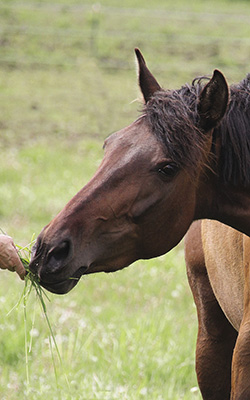
Courtesy of Heather Bashow
Methods
Can Praxis is currently in the process of validating the following two self-report instruments to assess the benefits of participating in their PTSD-tailored EAL program: 1), the 35-item Horses Relieving OperationaL Stress Through Experiential Relationships (HOLSTER) Scale;11 and 2), the 34-item Benefitting from Experiential Learning Together (BELT) Scale.12 Both instruments include the following two dimensions: 1), the acquisition of interpersonal skills and knowledge toward using a self-mediation process; and 2), the perceived relief from PTSD symptoms during the EAL session.
The HOLSTER scale was independently reviewed by seven content experts prior to starting the pilot testing process. The reviewers had experience with treating individuals with PTSD, experience and accreditation in facilitating EAL programs, or, in two cases, experience in both domains that ranged from 15 to 35 years. The content review experts included registered psychologists, social workers, an addictions counsellor, a physician, and PhD researchers in both animal sciences and PTSD trauma. The content review process resulted in 35 best-fit items for pilot testing the HOLSTER, commencing in March, 2013. The BELT scale for the spouses/partners was adapted from the HOLSTER scale, and it was first released for the second pilot testing session in May 2013.
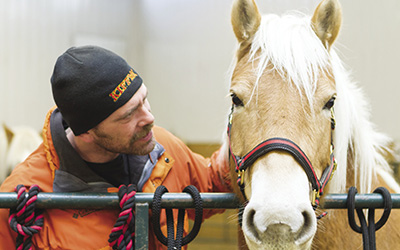
Matthew Wocks
Participants
The Can Praxis pilot testing commenced in March, 2013 and as of October 2013, a total of 31 veterans and 27 spouses/partners have participated in seven EAL sessions hosted at the Can Praxis facility near Rocky Mountain House, Alberta. In one case, a daughter participated in the program along with her veteran father. Thirty of the veterans recruited for the Can Praxis program were male, and one veteran was female. All veterans had been diagnosed with PTSD, including OSI. These veterans have come from all across Canada, from British Columbia to Newfoundland.
Results
Assessment Based Upon the HOLSTER Scale
The relatively small sample of participants (N = 31) dictates that only a basic descriptive examination of the veterans’ EAL experience has been reported at this early stage of pilot testing. Therefore, the results based upon the HOLSTER were only examined for the following two subscales, as reported in Figure 1.1. The Relieving Symptoms of PTSD subscale has a maximum possible score of 54, and the range of scores was 23 to 54 (M = 46.3, SD = 7.6). The Acquisition of Coping Skills subscale has a maximum possible score of 48, and the range of scores was 35 to 48 (M = 45.8, SD = 3.5).
| Organization: | Relieving Symptoms of PTSD: | N | Acquisition of Coping Skills: | N |
|---|---|---|---|---|
| No Perceived Benefit | 0–18 | 0 | 0–16 | 0 |
| Some Perceived Benefit | 19–36 | 4 | 17–32 | 0 |
| Very Positive Perceived Benefit | 37–54 | 27 | 33–48 | 31 |
| Totals: | 31 | 31 |
Authors
Figure 1.1 Assessment of Veteran’s EAL Experience Based on the Two Subscales of the HOLSTER
The early trends for participant benefits attributable to the Can Praxis EAL experience are very promising. First, as detailed in Figure 1.1, 87.1 percent (27 of 31) veterans reported very positive perceptions about relief from their PTSD symptoms during the EAL session. The remaining four veterans (12.9 percent) reported at least some reduction in their PTSD symptoms, based upon the EAL experience. Secondly, as shown in Figure 1.1, 100 percent (31 of 31) of the veterans reported very positive perceptions with respect to acquiring new or enhanced self-mediation coping skills during the EAL session.
Assessment Based Upon the BELT Scale
Similar to the HOLSTER, the current sample (N = 25) dictates that only a basic descriptive examination of the spouses’/partners’ responses for the following three subscales of the BELT has been reported at this stage of the pilot testing: 1), the Spouses/Partners Own EAL Experience subscale; 2), the Veterans’ Relief of Symptoms subscale; and 3), the Veterans’ Acquisition of Coping Skills subscale. The valid sample for the descriptive analysis is only 25, as the BELT scale was not available to the three spouses/partners who participated in the first pilot testing session in March 2013 (see Figure 1.2).
The early trends for spouse/partner benefits attributable to the Can Praxis EAL experience are also very promising. As detailed in Figure 1.2, 96.0 percent (24 of 25) of spouses/partners reported very positive feelings with respect to their Own EAL Experience. This subscale of the BELT included 80.0 percent (8 of 10) of the items measuring their acquisition of coping skills (i.e., communication and conflict resolution skills), and 20.0 percent of the items measuring how safe and comfortable they felt overall in attending the EAL session. The Own EAL Experience subscale had a maximum possible score of 30, and the range of scores was 15 to 30 (M = 27.9, SD = 3.2).
| Category | Own EAL Experience | N | Veterans’ Relief of Symptoms | N | Veterans’ Acquisition of Coping Skills | N |
|---|---|---|---|---|---|---|
| No Perceived Benefit | 0–10 | 0 | 0–12 | 0 | 0–8 | 0 |
| Some Perceived Benefit | 11–20 | 1 | 13–24 | 3 | 9–16 | 2 |
| Very Positive Perceived Benefit | 21–30 | 24 | 25–36 | 22 | 17–24 | 23 |
| Totals: | 25 | 25 | 25 |
Authors
Figure 1.2 Assessment of the Spouse/Partners Own EAL Experience and Their Perception of the Benefit to Veterans Based on the Three Subscales of the BELT
As shown in Figure 1.2, 88.0 percent (22 of 25) of spouses/partners rated the veterans as having had a very positive reduction with respect to PTSD symptoms during in the EAL session. This Veterans’ Relief of Symptoms subscale included 12 items that measured the spouses’/partners’ perceptions of the veterans’ observable behaviour specific to being more calm, feeling less fatigued, having less anxiety, being less depressed, being able to control the remembered sadness, and being ‘in the moment,’ among others. This subscale had a maximum possible score of 36, and the range of scores was 21 to 36 (M = 31.2, SD = 4.8).
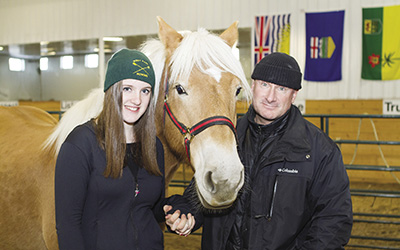
Matthew Wocks
In addition, Figure 1.2 shows that 92.0 percent (23 of 25) of spouses/partners rated the veterans very positively for acquiring the coping skills necessary to improve their personal relationships. The findings indicated that veterans had a positive emotional experience, tended to think before reacting to situations, used the new communication tools, were more aware of their own body language, and better understood personal boundaries. This Veterans’ Acquisition of Coping Skills subscale had a maximum possible score of 24, and the range of scores was 13 to 24 (M = 22.0, SD = 3.0).
Conclusions
Overall, the results from the seven pilot testing sessions provide initial support that the Can Praxis PTSD-tailored EAL program has been implemented as intended. The present study indicates that both veterans and their spouses/partners have acquired new skills and knowledge to implement a self-mediation process to help work through their relationship issues. Subsequently, 100 percent of veterans, and 96.0 percent of the spouses/partners reported learning new and/or enhanced communication and conflict resolution skills that gave them hope for improved personal relationships as they move forward.
“…as a wife, this is the first time I have felt like a part of the process & the solution. This [Can Praxis ] program has given me faith that our marriage will work if we work on it with the tools & understanding we were given.”
Session 6 Participant
The findings also support the benefits of using horses in experiential learning to leverage awareness of the self-mediation concepts incorporated into the Can Praxis EAL model. The findings that 87.1 percent of the veterans reported reduced PTSD symptoms during the EAL session suggests that the horse activities elicited positive experiences. If the veterans were not able to get control of their depression, intrusive thoughts, and/or hyper arousal and be ‘in the moment’ during the equine activities, making a positive connection with the horses would have been compromised. This suggests support for the proposition that repairing a neglected relationship can benefit from having a positive experience with an animal that has a non-judgemental listening ear. Therefore, the founders of Can Praxis remain confident that the interaction with horses helps to move people, ‘hardwired’ to rely heavily upon language, to learn valuable non-verbal communication techniques through understanding their body language.13
This article serves as a seminal document for continued research to obtain an optimum level of empirical evidence to satisfy the requirements of the scientific community toward establishing appropriate PTSD-tailored EAL programs as evidence-based practices. This research also supports the notion that appropriate PTSD-tailored EAL programs, such as Can Praxis, be considered in the long-term mental health strategies for veterans and members of other military/paramilitary organizations exposed to combat trauma.
Randy Duncan is currently a Research Consultant with the Department of Sociology at the University of Saskatchewan. He is currently pilot testing several instruments designed to measure the benefits of Equine Assisted Learning for at-risk youth and adults. This has led to a partnership with Can Praxis to conduct a study of the benefits of EAL for veterans and their spouses/partners suffering from the effects of PTSD, including Operational Stress Injury (OSI).
Steve Critchley, a former member of the Canadian Armed Forces, is now an international consulting mediator and trainer. In addition to his work as a facilitator with the Can Praxis program, Steve has provided harassment investigator and harassment advisor services for the Canadian and US federal governments, as well as providing training in South Africa, Ghana, Milan, London, and Dubai.
Jim Marland, a registered psychologist, has had a career that includes over 30 years of intermittent experience in corrections, which has given him a deep understanding of human nature, human needs, and human behaviour. More recently, he has combined his professional career with his 40 years of experience with horses. “For thousands of years, people have experienced the practical and profound contribution horses make to our lives,” said Marland. He uses horses’ instinctive responses to human body language to help teach participants communication, teambuilding, and leadership skills.
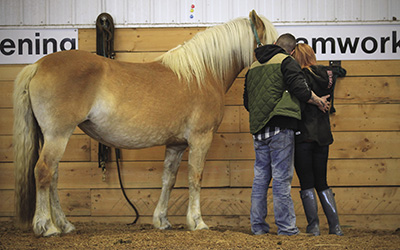
Stuart Gradon, The Calgary Herald, <http://www.calgaryherald.com>. Reprinted with permission of The Calgary Herald
Notes
- Ashley B. Hart, An Operators Manual for Combat PTSD: Essays for Coping. (Lincoln, NE: iUniverse.com, Inc., 2000), p. 139.
- Ibid., p. 37.
- Veterans Affairs Canada (2008). Evaluation of the Operational Stress Injury (OSI) Clinical Network. at http://veterans.gc.ca/eng/department/reports/deptaudrep/osi_eval_oct08
- Ibid.
- Kay S. Trotter (2012). Harnessing the Power of Equine Assisted Learning: Adding Animal Assisted Therapy to Your Practice. (New York: Routledge [Taylor & Francis group], 2012), p. 5.
- Ibid., p. 27.
- Rebecca Coffey, Unspeakable Truths and Happy Endings: Human Cruelty and the New Trauma Therapy. (Lutherville, MD: Sidran Press, 1998), p. 84.
- Ibid.
- Daniel Dana, Managing Differences: How to Build Better Relationships at Work and Home [4th Edition], ( Prairie Village, KA: MTI Publications, 2006).
- Bruce D. Perry, “Applying principles of neurodevelopment to clinical work with maltreated and traumatized children,” in Boyd E. Webb (Ed.), Working with Traumatized Youth in Child Welfare. (New York: Guilford Press, 2006), p. 38.
- C. Randy Duncan, Horses Relieving OperationaL Stress Through Experiential Relationships (HOLSTER) Scale (Scale in Development). Saskatoon, SK, 2012.
- C. Randy Duncan, Benefitting from Experiential Learning Together (BELT) Scale (Scale in Development). Saskatoon, SK, 2013.
- Leif Hallberg, Walking the Way of the Horse: Exploring the Power of the Horse-Human Relationship. (Bloomington, IN: iUniverse.Inc, 2008), p. 113.







